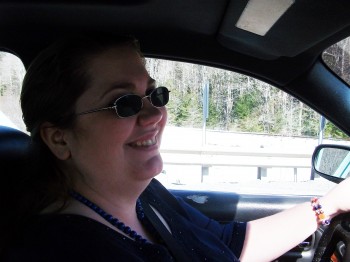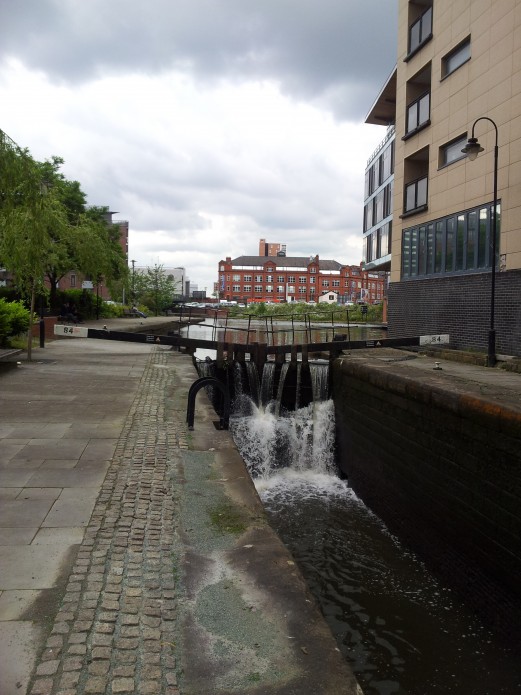Finally done with that idiocy!!! It’s not a test of how to drive, mind you. There are a few elements of driving in there to fool those who don’t look very closely – you have to make the car go, stop, and steer it. But if you’ve not passed one of these in the past three years or so (or ever), realize that they change all the time. What sorts of things did I need to know and do to pass? I won’t remember them all for this write up (I remember them better when doing them, while driving), but here’s a sampling:
- When you get in the car, adjust the seat first, and then the mirrors. You’ll get docked if you adjust the mirrors before you adjust your seat, even if you then adjust your mirrors again.
- Remember when adjusting the seat to check the head rest* for yourself and your examiner, and adjust if needed. (*It’s a head restraint in the literature, which makes me have visions of strapping your head to it…)
- Before setting off, do your 6-point sweep to make sure you see “everything”:
- Look behind the passenger, in the blind spot
- Look at the passenger’s side mirror
- Look out the front window
- Look at the rearview mirror
- Look at the driver’s side mirror
- Look over your shoulder, in your blind spot. Remember to show the examiner the back of your head this time.
- Every other time you check either blind spot, don’t turn your head – the book tells us this is dangerous, since you could “lose touch” with what’s going on in front of you. Only give a “quick sideways glance” to see what’s going on over your shoulder.
- When setting off from being parked at the side of the road (which you’ll do about half a dozen times during the test), put your blinker on if any road users are about to benefit from it, but otherwise don’t. If there’s a pedestrian on the sidewalk near enough to you, then yes, but if they’re far enough away, then no. If they’re working in their garden, then they’re not a road user, so no.
- Every single other time, use your blinker when turning, changing lanes, etc.
- Handling the Steering Wheel: Always hold it with two hands, unless you must operate something else vital like the gear shift, the handbrake (emergency brake), windshield wipers, etc. Your left hand always stays on the left side of the wheel, and your right hand always stays on the right side of the wheel. This isn’t strictly necessary, but the “feeding” or “pull-push” method of steering has become so widespread and engrained in instructors and examiners that it was easier to develop the habit in myself than to run the risk of having an examiner who didn’t understand the finer points.
The requirement is that you maintain complete control at all times. They no longer require that you have your hands at 10 & 2 (or “ten to two,” as they say here), so there’s some flexibility: you can try 9 & 3 if you prefer. I never did push it and try 5 & 7, though. 😉 This one took quite a bit of practice to engrain in myself – I’m so used to just using the heel of my right hand to spin the wheel to make a turn. (That’s going to horrify my British readers just like it horrified my driving instructors – they believe you’re not in control of the car when you do that, because “what if you hit something?”)
- A maneuver is defined as anytime you change speed or direction.
- To make any maneuver, do this sequence, in this order:
- Mirror: Check your inside mirror. Make sure there isn’t someone too close to do whatever you’re about to do. The examiner has to see you look in your mirror.
- Mirror: Check your side mirror. If you’re turning left, check your left mirror to make sure there are no bicyclists or motorcyclists coming up beside you. If you’re turning right or passing parked cars, make sure there are no motorcyclists coming up beside you (they like to sneak between the lanes of traffic, which seems to actually be legal), or anyone passing you.
If you’re on a bend and can’t see anything out of the “appropriate” mirror, check it anyway. It’s a minor fault if you don’t. You can then go on to check the mirror you can actually see something out of, but you don’t get extra credit for this, and aren’t encouraged or discouraged to do this by the book.
- Signal: There are a lot of signals to use; I can only remember two right now. (1) Put your blinker on. (2) Touch your brakes so the brake lights come on. Don’t signal before you check your mirrors; that’s a minor fault.
- Position: Get your car to the left, right, or center of your lane as appropriate, or move into the right-turn-only lane that’s just popped up, for example. The roads here being so much more narrow than American roads, this was laughable to me to start with. Turns out the answer is that in my town, the roads are exceptionally narrow – they’re wider in the town I tested in – and they have far too many parked cars, so it truly is laughable here (aside from the main roads and the new estates). In other towns, it’s less so – they sometimes manage to make cars narrow enough and roads wide enough and drivers used to having little enough space that they can squeeze past someone waiting to turn right, if that person’s scooted right up to the right edge of the lane.
- Speed: Now slow down (or speed up).
- Look: Look for other traffic when you reach a point from which you can see.
- Assess the situation.
- Decide to go or wait.
- Act accordingly.
- Major Maneuvers: There are 5 of these, and they’ll generally test you on 2.
- Turn in the Road: Also called three-point-turn, though you can take five points if you need (which is why they changed the name). You’re not allowed to touch the curb, or take more than five points. Make sure you look through the rear window when reversing. Stop and put the emergency brake on if a pedestrian comes along behind or in front of you or if a car decides to pass. When you’re nearly at the edge of the road each time, turn the wheels fully the other way so they’re ready to start the next bit. Don’t “dry steer” – steer when the car isn’t moving.
- Reverse around a corner: Find a side road to the left (usually). Pull past it about two car lengths, and stop on the left. Stay one meter (one yard) from the curb, reversing around onto that side street until you have about two car lengths of clear road in front of you. You have to look in your passenger’s side mirror to keep that meter from the curb, but you have to look through the rear window because you’re reversing, and you have to look all around every so often in case anyone’s come up in any other direction. If anyone comes up from anywhere, stop and wait, emergency brake on, until they pass. Very rarely, they use a side road to the right to do this, but that’s easier because you can just look out your window and see the curb.
- Emergency Stop: When the examiner says STOP, press the brakes very quickly (as if there were suddenly someone in the road). Pump them if necessary to avoid skidding (info on this is in the book).
- Reverse parallel parking: You pull up beside a car, lining yourself up with its headlights (if it’s pointed the right way). Then you reverse to park behind it (parallel to the curb). This is actually a good one to learn, provided you can get traffic behind you to stop and wait. Reversing in means you only need 1.5 car lengths of space free instead of the 3 car lengths the papers tell me you need to pull in forwards, and if you learn it well, you’re less likely to hit the curb. Curbs here are low, so it’s not actually such a problem, but in some places hitting a curb could give you a blown tire, so y’know, that’s useful to know.
- Reverse park into a parking bay: A lot like the reverse around a corner, but with less traffic and much more precision, of course. I routinely park this way (you can see so much better when you leave if you’ve backed in or pulled through), but am thankful it wasn’t another hurdle on my test – they only do this at test centers that have parking bays, and Buxton’s doesn’t.
- At all times, the overarching mantra is DO NOT INCONVENIENCE OTHER ROAD USERS as much as possible. So when you set off from the side of the road, if there’s a car coming, you wait for it to pass rather than take the chance that it might have to slow down because you’ve pulled out. This is a judgement call, of course – can I get up to speed before that car catches up to me – so you just wait if there’s a car in sight at all, because the examiner will probably have a different opinion than you.
- To be clear: waiting’s okay by me. I’m completely fine with waiting. Except for the bit where they get you for “undue hesitancy” – if you don’t go when they think you should, that’s a minor fault. We’re not to “hold up traffic unnecessarily.” In real life, the book warns us that many wrecks happen at roundabout entrances when the second person in line is watching the roundabout traffic and assumes the person in front of them has gone because they’d have gone, and rear-ends the first person because it turns out they didn’t go. Can’t teach people to look at the cars in front of them before they go, so instead we’ll teach people to go ASAP. Clearly this makes more sense.
- Speed: Obviously you can’t speed. You don’t have to worry about going a couple over for a minute, so long as you bring it back down. But you also can’t go too slow. Obviously if you’re crawling along in traffic, then that’s that, but if you’re going 20 in a 30 for no apparent reason, that’s a minor fault. If you don’t get up to 60 on the country roads that are twisty, hilly, possibly being actively rained on at that moment, then that’s another minor fault. One student I was told about failed one test because someone passed (overtook) her while she was on her test. Her own speed didn’t even matter. Most of those roads are really short, so you have to gun it – but without flinging your passenger about – and get up to that speed before gently slamming on the brakes when that 30 sign pops up. One of those roads has a 60 zone for 0.2 miles; it’s so stupid. Another is a 60 road for a decent length, but it’s very narrow, and it has SLOW written all over the road with warning signs out the wazoo – I would rezone it to 30 at most, or possibly 20. Certainly when passing cars, 20 is the fastest safe speed because of the narrowness (see the next point).
- Distance: You need to keep a meter (a yard) from the edge, generally. This means a meter from the curb, or the parked cars, or the wall alongside the road, or the hedge, etc. The rule of thumb is that if you have the space to keep a meter away, then you can go 30mph; if you can only keep 2 feet (2/3 meter), then drop your speed to 20mph; if you can only keep 1 foot (1/3 meter), then drop your speed to 10mph. Find or put something on your dash to line up to the edge (whether it’s the curb or the parked cars) and keep it there. I had lots and lots of trouble with this.
- Put on your emergency brake (handbrake) when stopping with a pedestrian crossing in front of you. It provides a tiny little extra bit of protection to the pedestrians in case someone rear ends you.
- Independent driving section: It’s such a misnomer. Anyway, so here’s what happens. For most of the test, your examiner says, “I’d like you to take the next left,” or “Please take the second right, on the bend.” Then, for about 10-15 minutes of your test, you’ll have one or a mix of three things for your directions happen:
- Follow signs – “Follow the signs to Macclesfield”, for example
- Shown diagrams – like these:

- Given a list of directions – “Turn right at the end of the road and then go straight through the traffic lights,” for example.
It doesn’t matter if you miss a sign and go the wrong way, so long as you do it safely. It’s hard to remember that in the heat of the moment, though, when everything else has to be perfect.
- You can’t cut corners, which means go into the other lane when you’re turning. You have to line up the car so that you stay only in your own lane. You really do, because that’s what everyone expects, so you’ll cause wrecks if you don’t master this one, even though the roads are absurdly small.
- Don’t brake or change gears during bends. You need both hands to steer in a bend.
- If you test in a stick shift, you have to be in the right gear at all times. If you’re in the really wrong gear, the car stops going (voice of experience here), which I could understand counting as a fault. But no, they’re talking about just being one gear above or below what they deem you “should” be in. The book talks about fuel consumption considerations.
- The book warns you to be gentle with the gas and brake so as to also use less fuel. This is fair enough, too, and to be honest, I’m glad they’re trying to turn out drivers who drive more gently: it’s far more comfortable for the passengers. I’m glad I’m already this kind of driver, but it does add one more thing to worry about to this laundry list – a sudden stop to avoid hitting something, and I’m not sure, is that a minor fault in this category? Is that in addition to a minor fault in the observation category? Hm.
- You can’t curb check at any point – touch the curb or go up onto it. “The examiner will see that as though you’ve just driven over some pedestrian’s toes,” my instructor warned me, whether anyone’s around or not. It’s all presented as being about what COULD happen, possibly, maybe, perhaps. (More on this below.)
Three minor faults in one category will fail; 15 minor faults altogether will fail; a single major fault will fail.
I know I’ve left things out, but there’s a sampling to get you started.

It was a glorious day of sunshine – I remembered to take a photo while I was on the train.
With that Mirror-Mirror-Signal-Position-Speed-Look-Decide-Act sequence, I had a great deal of trouble with the first few – always the inside mirror, then the appropriate side mirror, THEN the signal. These are things the practiced driver doesn’t even think about – try to pay attention when you next drive to see what you do. I put my blinker on first, and check my side mirror first if I’m on a bend (which is what I’ll go back to, because it affords the best view). Position was an entirely new thing to learn; speed just sort of happened in conjunction with the first few steps, not as a separate thing later. The last few were fine.
I was so worried about that bit that the examiner has to SEE you check your mirrors. Chris and I joked about having to make exaggerated head movements. Thankfully, in the end, I didn’t need to. The one I had must have seen me check them, because I didn’t get any faults for not checking my mirrors yesterday.
I had so much trouble with the sequence, though, that I just chanted it to myself: “Mirror Mirror Signal Position Speed”. The night before the test, I stuck notes all around the house with MMSPS written on them. I didn’t mention to Chris what it was about at all. Later, he came to me:
Chris: “I’ve got it.”
Me: “What’s that then?”
Chris: “M&Ms Stop Police Sirens.” (He hadn’t actually told me he was referring to the notes around the house.)
Me: “…Well, I suppose if you get enough of them, and bury the police car in them … or possibly put them in a specific place to disable the soundmaker … What brings this on?”
Then he told me about seeing the notes. I laughed, and told him what they really stood for, which of course is far more boring. I’ve not forgotten Mirror-Mirror-Signal-Position-Speed, thanks to M&Ms Stop Police Sirens. 🙂

There was a beautiful sunset on our way home.
Everything was that much harder because I already know how to drive. The bit of me that says, “That’s a stupid way to do that, it should instead be done this smarter way” – like checking the mirror that shows you nothing when you’re on a bend – just had to be shut up for long enough, and I just had to Do What The Book Told Me Regardless. That bit of me that was indignant at being treated like I didn’t know anything also had a really hard time; poor Chris has had more than his share of listening to me rant through this process. Truth is, it’s always easier to train someone from scratch than it is to retrain; one of my first bosses actually refused to hire anyone who’d had any previous jobs just so he wouldn’t have to deal with retraining issues. (It was McDonald’s, so he could do that.) The whole system is geared at those who don’t know how to drive; those of us who already do know have a really hard time. Of course, everyone rates themselves as an above average driver, so this means few like to be told where they need to polish up.
They want you to anticipate other road users’ needs and actions, but only to a point. They want you to look down the road, instead of focusing inside the cab of the car like a beginner, but I was chastized over and over by my instructor when I anticipated too much. You sort of need an intermediate level, so I had to back down what I would react to – but not too much. At one point, the correct answer was that I was better off causing a traffic jam (between parked cars, oncoming traffic, and what the car behind me was doing) than getting a bit closer to the car in front of me. Right.
It really isn’t about Just Driving. If it’d been about Just Driving, heck, it would’ve been a walk in the park – or easier, given my foot problems! It’s about doing things by the book, the exact way they want you to do them, to the level they want you to – only an intermediate level.
In the end, though, the vast majority of it comes down to luck. Obviously, you need to be able to make the car go, etc. But yesterday, the examiner was just in a really good mood: I curb checked coming around a really tight bend towards the end of the test and was sure I’d failed, but lo and behold, the examiner decided that no, “lightly touching a curb” was only a minor mistake and didn’t need a failure. I was thanking my lucky stars all day yesterday, and am still today.
I didn’t actually believe him when he said I’d passed. “Well, I’m pleased to inform you that you’ve passed …” he said words after that, but they all sounded like Charlie Brown’s teacher as I reeled in disbelief.
I finally interrupted him to say, “I’m sorry, did you say I’d passed?” He smiled a bit and said, “Yes, you passed. You thought you’d failed when you lightly touched that curb, didn’t you? I could see it drain out of you.” Yep, yep it had. I’d checked everything else my driving instructor had said in the book to make sure he told me right (because we’re all only human), but that’s the one thing I didn’t check. I think the truth is that it depends on the examiner and their mood, and the severity of the curb check. Easier to teach the student to not curb check.
Oh, and? That “independent driving” section is really stressful for me, because reading road signs while simultaneously keeping everything else in mind to be perfect about is just about more than I can do. Guess what I got to do AT THE SAME TIME yesterday? That section – with a cop on my tail. Because I needed ALL THE STRESS, clearly! I think I absorbed it for the whole wide world for that particular ten minutes, actually. So much for being okay to go one or two mph over for an instant!
Anyway, it’s finally DONE. At last! We shall soon be properly mobile over here! Hip hip hooray!
This is what I felt like doing yesterday 🙂
When I got home, I hopped on the train to go straight into Manchester to tell Chris in person. I took a book to read on the train, and happily read until a pair of males decided to sit near me and talk very loudly. Even my ear plugs (a vital necessity for public transport – I go nowhere without them) didn’t muffle them much. It was a good reminder of why I’d just put myself through this wringer. The indecently high train fare, and the 2-hour 17-mile trip also underscored that.

The sunset was behind us, but this picture came out too dark – you can have us or the sunset, but not both at the same time.
Yes, I’m looking very much forward to having my own car here.












